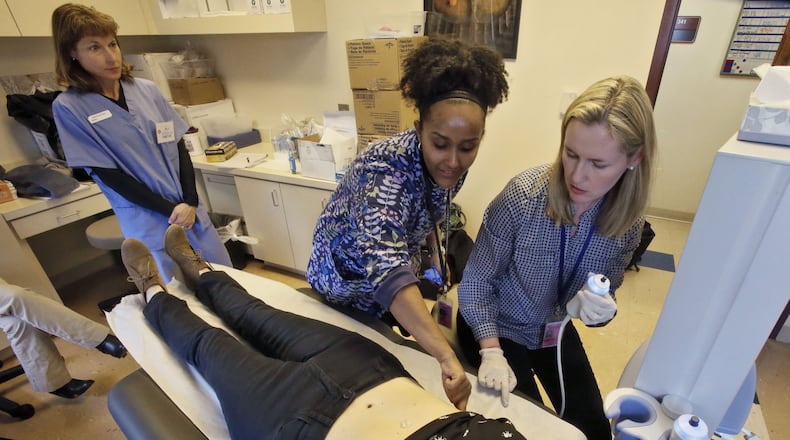Additional information about the Atlanta WIHS, contact the project director, Sara Sanford, at sesanfo@emory.edu,
or call SisterLove at 404-254-4734.
Her biggest hope is that a cure will come soon. But either way, Lauryn Taylor will make the 45-minute bus ride to take part in the Women’s Interagency HIV Study for as long as she lives.
Maybe it’ll make a difference in her life. Maybe it won’t. But, if her showing up twice a year will help scientists better understand why women are more susceptible to the deadly virus, if it will keep her 20-year-old daughter and other people’s children safe, Taylor said she intends to do her part.
“I’ll do it as often and for as long as I need to,” she said.
Taylor is one of 40 women age 18 and over — some who HIV positive and some who are at risk of becoming infected — currently enrolled in the study. Emory University researchers are hoping to recruit 260 more.
The study, which launched Oct.1, is the National Institutes of Health’s response to the growing HIV/AIDS epidemic in women.
“When the epidemic first broke in the ’80s, women in the U.S. comprised only 8 percent of people with HIV/AIDS,” said Dr. Igho Ofotokun, an associate professor of medicine at the Emory University School of Medicine and one of the lead researchers of the study. “Two decades later, nearly 25 percent of all people living HIV/AIDS are women in the U.S.”
Although the south has long been a breeding ground for the deadly disease, this is the first time in the two decades since the WIHS was first launched in 1993 that research sites have been located here. Atlanta is one of four new southern sites, a recognition of the epidemic's disproportionate impact on women here. The others are located in Miami, Birmingham and Chapel Hill, N.C.
Ofotokun said that he and partner Gina Wingood, a professor of behavioral sciences and health education at the Rollins School of Public Health, were told from the outset that approval for a local site was an uphill battle, but they persisted because both he and Wingood had spent much of their careers working with HIV-infected women like Taylor.
“We were convinced there were no others like us,” Ofotokun said. “This was our life, and we felt there was no better place for this work than Atlanta, where the epidemic just happens to be raging. We have the largest number of AIDS cases in the southeast.”
There are an estimated 14,000 women living with HIV/AIDS in Georgia. Fifty-six percent of those live in Atlanta.
“What is scary is these are women of child bearing age, and they can transmit the disease to their offspring,” Wingood said
Under Ofotokun’s and Wingood’s guidance, researchers will conduct detailed clinical, neurocognitive, behavioral and genetic assessments in hopes of understanding HIV progression in women and what specific factors, such as biology, stigma, medical distrust and social behavior, increase women’s vulnerability to infection.
“Women are more likely to become infected compared to men,” Wingood said. “The question I ask myself as a scientist is what makes them more susceptible?”
Taylor, 45, of Decatur, has been under Ofotokun’s care since learning of her diagnosis three years ago.
“It was Dec. 14, 2010,” she said. “I got in my car and I cried and screamed and cursed for about 15 minutes. Then I just absolutely engorged myself with information about the disease.”
It was the same way, Taylor said, when she learned about WIHS.
“I’m a paralegal by trad,e so naturally I started doing some research,” she said. “I was really excited to find out that the study was backed by the NIH and the focus was how the virus affects women.”
One of the strengths of the Atlanta site, Ofotokun said, is the relationship it has forged with its community partners, SisterLove, AidAtlanta, the Center for Black Women’s Wellness and others.
“They have been part of helping us develop operations, how to recruit women, in every decision we make,” he said.
Dazon Dixon Diallo, president and CEO of SisterLove, said the local non-profit decided years ago to become more directly involved in institution-based research.
“We wanted to be a local leader on that, and so we were very intentional about working with Emory researchers and other local institution,” she said. “We started out just being a partner in community education, educating people about clinical trials and what works, what trials are available, then built our own capacity to conduct research, which elevated us to become a partner in the research itself.”
Diallo said the agency encouraged Emory to apply for the NIH funds — $12 million over 5 years — and assisted with writing and submission. The study is being conducted at the Grady Infectious Diseases Program Clinic (The Ponce Clinic) and the Woodruff Extension Building at Grady Emory Campus.
“What really drove us is the concentration of women with HIV in the south,” she said. “For many women in the study, it will be a lifetime of state-of-the-art health care, the Cadillac of every thing you will need living with HIV but don’t have the means to pay for health insurance. As part of the research protocol, they will be evaluated twice a year and may be screened for cancer, hypertension, cardiovascular disease and even violence from their entry into the study until they die. That’s what makes this so powerful.”
Daillo said that, for a lot of women in the study, participating will be a chance to feel like they are part of the solution to ending the epidemic.
Taylor said she intends to be completely involved in as many aspects of the study as she can and hopes people who may be at risk of the disease, or naïve about how it’s transmitted, will begin to protect themselves.
“I have a 20-year-old daughter and since HIV has been renamed a chronic condition instead of a death sentence, I feel like her generation, in particularly, no longer takes it seriously,” she said. “This is not like a cold. It does not go away, so why gamble? Every time you have unprotected sex, you are playing Russian roulette with your life.”
Taylor and researchers say WIHS holds much promise for women, if for no other reason that it will inform U.S. policy on HIV/AIDS.
“We can win the fight against AIDS, and this study will give us the tools to begin to understand the factors that will eventually help us,” Ofotokun said.
> RELATED: Why women need to be blunt in asking about their man's sex life
About the Author
Keep Reading
The Latest
Featured



